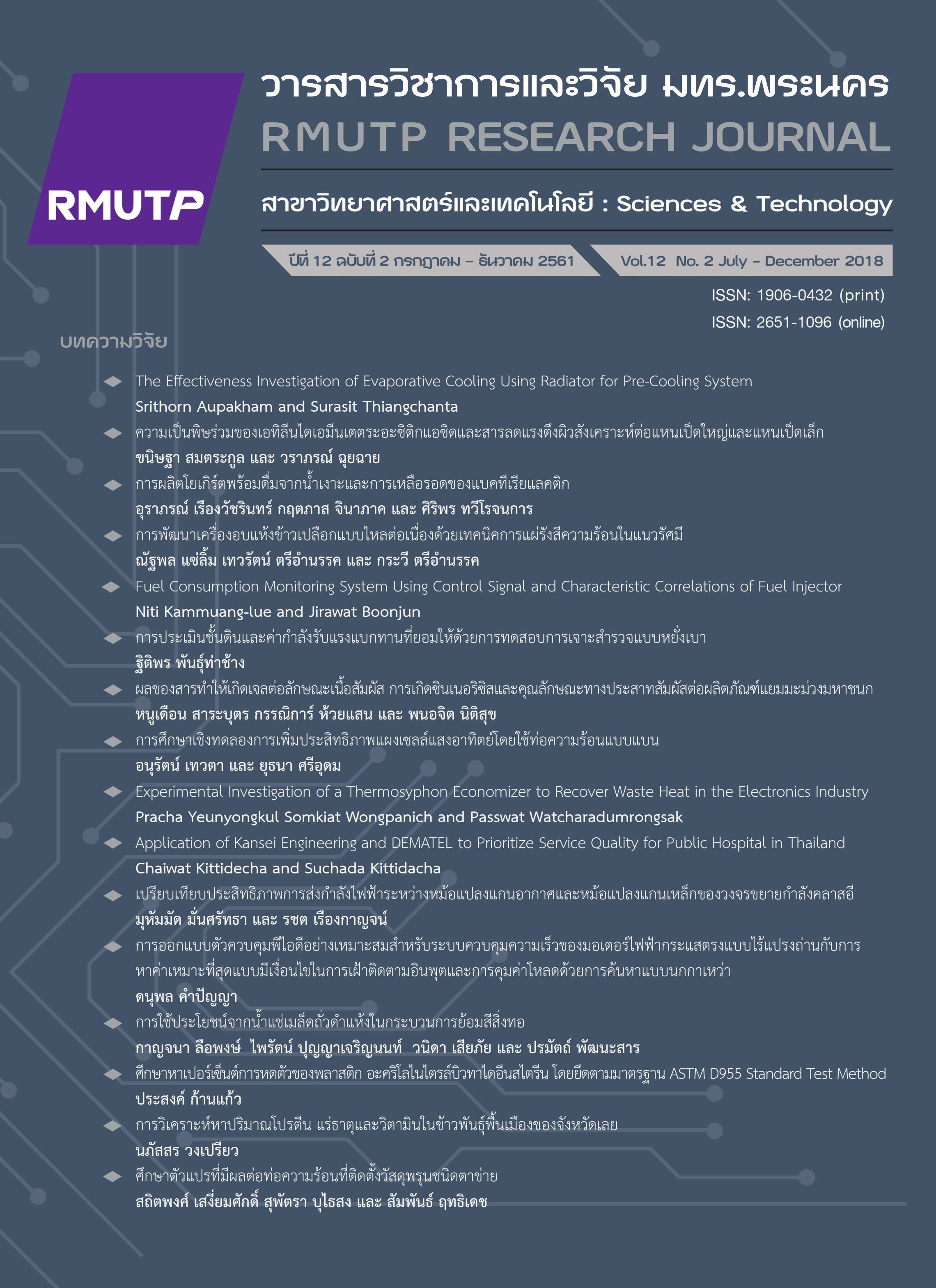Development of a Continuous Flow Paddy Dryer with Infrared Radial Radiation Technique
Main Article Content
Abstract
The objective of this research was to design and development of a continuous flow paddy dryer with infrared radial radiation technique. The prototype of dryer consists of two concentric circular cylinders, which the paddy drying chamber is height of 1 m. The inner cylinder has diameter of 26.5 cm made from glasses and the outer cylinder has diameter of 29.5 cm made from perforated (1.75 mm) steel sheet. At the center of cylinders installed 1,200 W of electric infrared heater. A hopper was installed on the top of the chamber while 120 W of blower and paddy flow control were installed at bottom of chamber. The performance of the dryer in terms of specific energy consumption (SEC), drying rate (DR) and quality of paddy i.e. head rice yield (HRY) and whiteness index (WI) were evaluated by drying 15 kg of paddy with initial moisture content of 23-26% (w.b.) by using the drying conditions of 80°C of drying chamber temperature, 1.075 m3/min of air flow rate and 0.837, 1.228 1.875 and 2.308 kg/min of paddy flow rate. The results found that paddy flow rate at 1.875 kg/min is the optimum condition because gave the highest DR, lowest SEC and rice qualities (HRY and WI) closely to control.
Article Details
References
[2] J. Laohavanich and S. Wongpichet, “Thin layer drying model for gas-fired infrared drying of paddy.Songklanakarin,”J. Sci. Technol vol.30 (3), pp. 343-348, May-Jun. 2008.
[3] D. Zare, H. Naderi and M. Ranjbaran, “Energy and quality attributes of combined hot-air/infrared drying of paddy,” Drying Technology vol. 33, pp 570–582, Feb. 2015.
[4] G.P. Sharma, R.C. Verma and P. Pathare, “Mathematical modeling of infrared radiation thin layer drying of onion slices,” Journal of Food Engineering vol. 71(3), pp. 282–286, Dec. 2005.
[5] A.R. Celma, F. López-Rodríguez and F. Cuadros, “Experimental modelling of infrared drying of industrial grape by-products,”Food and Bioproducts Processing vol. 87(4), pp. 247–253, Dec. 2009.
[6] H.U. Hebbar, K.H. Vishwanathan and M.N. Ramesh, “Development of combined infrared and hot air dryer for vegetables,” Journal of Food Engineering vol. 65(4), pp.557.563, Dec. 2004.
[7] U. Teeboonma and S. Jongjam, “Ginger Drying Using Infrared-Vacuum Technique,” Burapha Sci. J. 15 (2), 76-86, 2010.
[8] J. Laohavanich and S. Wongpichet, “Drying characteristrics and milling quality aspects of paddy dried gas-fired infrared,” Journal of Food Process Engineering vol. 32(3), pp. 442–461, Jun. 2009.
[9] I. Das, S.K. Das and S. Bal, “Drying kinetics of high moisture paddy undergoing vibration-assisted infrared (IR) drying,” Journal of Food Engineering vol.95 (1), pp. 166–171, Nov. 2009.
[10] M. Tohidi, M. Sadeghi and M. Torki-Harchegani, “Energy and quality aspects for fixed deep bed drying of paddy,” Renewable and Sustainable Energy Reviews vol.70, pp. 519–528, Apr. 2017.
[11] T. Tipyavimol, P. Sangrung, and P. Sudtana. “Physical and Thermal Properties of Khao Dawk Mali 105 Rice” in proceeding of the 13rd TSAE national conference, Chiang-mai, Thailand, 4-5 Apr. 2012, pp. 526-531.
[12] A.R. Celma, F. Cuadros and F. López-Rodríguez, “Characterisation of industrial tomato by-products from infrared drying process,”Food and Bioproducts Processing vol. 87 (4), pp. 282–291, Dec. 2009.


